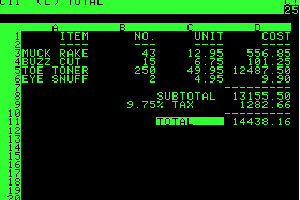30 years of the spreadsheet
The spreadsheet was the ‘killer app’ that helped popularise the personal computer - 30 years since its introduction we hail VisiCalc, the world’s first spreadsheet.


As with most great events, the birth of the personal computer is somewhat hard to pin down. Was it the introduction of the Altair, the first kit computer introduced in 1975? Was it the moment Bill Gates managed to get IBM to agree to pay for a licence of his company's operating system for every computer sold, or was it the first time IBM PC went on sale?
Whatever your opinion, there can be little doubt that a major milestone in the history of the PC in anyone's book was the first application that got people to look at the personal computer as more than just a toy. This was VisiCalc, the world's first spreadsheet, co-created by Dan Bricklin and Bob Frankston in 1979.
In these early days, computers were dismissed as being good for nothing more than playing games, but once the business community took a look at what the program could do, the need for a computer in the office became clear.
Ironically, while people associate PCs with boring' stuff like spreadsheets - a fact much played upon by Apple in its PC vs. Mac advertising campaign - the first spreadsheet was actually coded on an Apple II.
The idea
Bricklin recalls that the idea for VisiCalc came to him as a student at Harvard Business School, where doing an MBA he began to daydream about an inactive accounts ledger. "Imagine if I had a heads-up display, like in a fighter plane, where I could see the virtual image hanging in the air in front of me. I could just move my mouse/keyboard calculator around on the table, punch in a few numbers, circle them to get a sum, do some calculations, and answer '10 per cent will be fine!'"
Of course, Bricklin was a little ahead of the curve with a virtual HUD and eventually settled for a standard computer screen, envisioning the rows and columns that became the staple for spreadsheets. He coded the first version of the app on an Apple II that he borrowed from Dan Fylstra, who later became the publisher of the completed VisiCalc.
Sign up today and you will receive a free copy of our Future Focus 2025 report - the leading guidance on AI, cybersecurity and other IT challenges as per 700+ senior executives
The early name for the programme was actually Calcu'edger' but that was dismissed for its associations with traditional bookkeeping and accounting. Despite VisiCalc now sounding somewhat dated, the name does the job of emphasising the visual nature of the program.
When building the prototype, Bricklin used his own code to solve a business problem for one of his classes at Harvard Business School. The case was an analysis of the famous Pepsi-challenge' advertising campaign which ironically was run by John Sculley, who would later leave Pepsi to become chief executive of Apple - where he infamously fired Steve Jobs.
How did you ever do without it?
Despite the programme not being finished and not announced, an advert for VisiCalc appeared in the May 1979 issue of Byte Magazine, an early enthusiast publication, with the bold tagline, "How did you ever do without it?"
Around the same time, the programme was shown for the first time to personal computer press at the West Coast Computer Faire in San Francisco, but the anniversary we're hailing was its first showing to the public. This was at the National Computer Conference in New York City in June of 1979.
Benny Har-Even is a twenty-year stalwart of technology journalism who is passionate about all areas of the industry, but telecoms and mobile and home entertainment are among his chief interests. He has written for many of the leading tech publications in the UK, such as PC Pro and Wired, and previously held the position of technology editor at ITPro before regularly contributing as a freelancer.
Known affectionately as a ‘geek’ to his friends, his passion has seen him land opportunities to speak about technology on BBC television broadcasts, as well as a number of speaking engagements at industry events.
-
 Gender diversity improvements could be the key to tackling the UK's AI skills shortage
Gender diversity improvements could be the key to tackling the UK's AI skills shortageNews Encouraging more women to pursue tech careers could plug huge gaps in the AI workforce
-
 Researchers claim Salt Typhoon masterminds learned their trade at Cisco Network Academy
Researchers claim Salt Typhoon masterminds learned their trade at Cisco Network AcademyNews The Salt Typhoon hacker group has targeted telecoms operators and US National Guard networks in recent years
